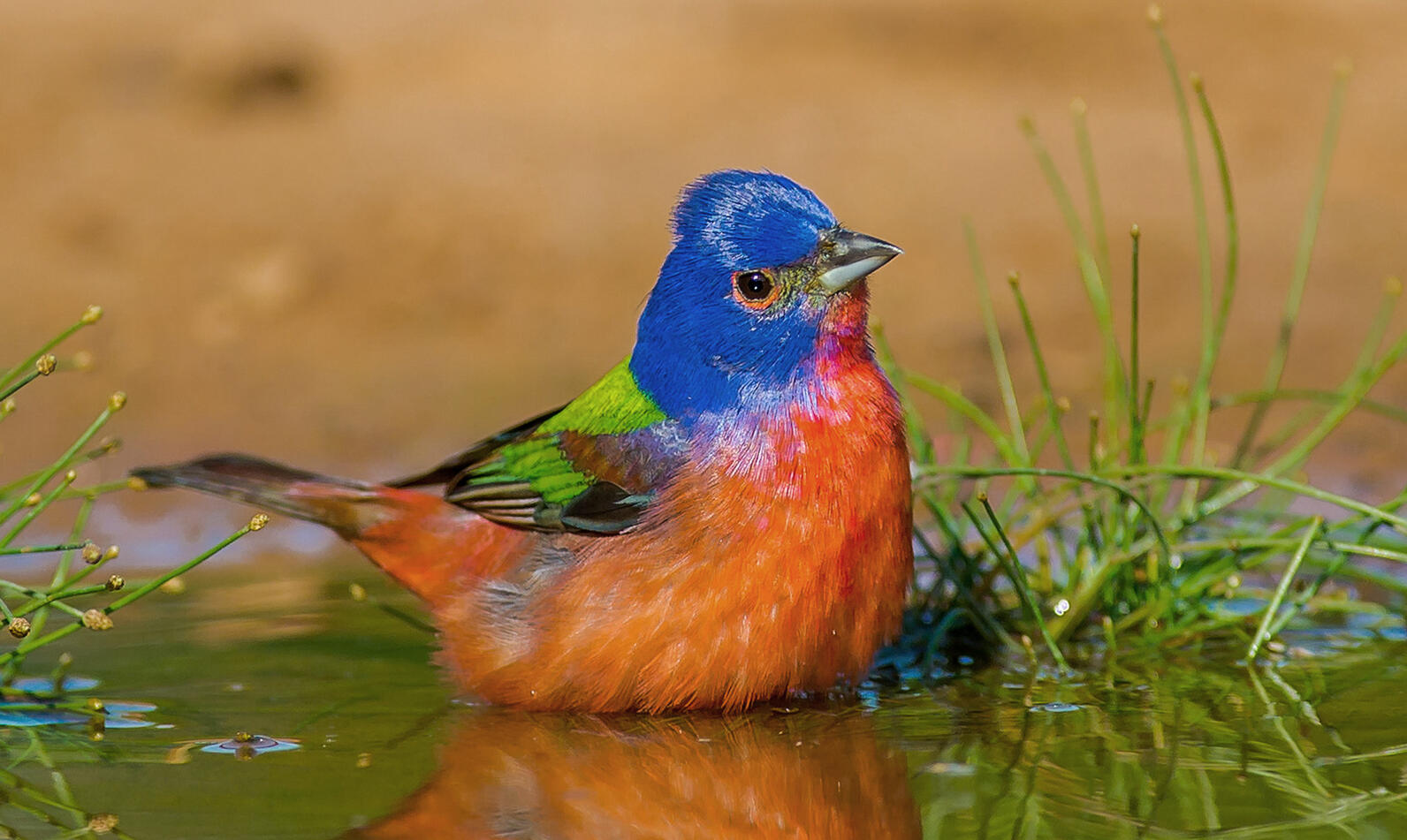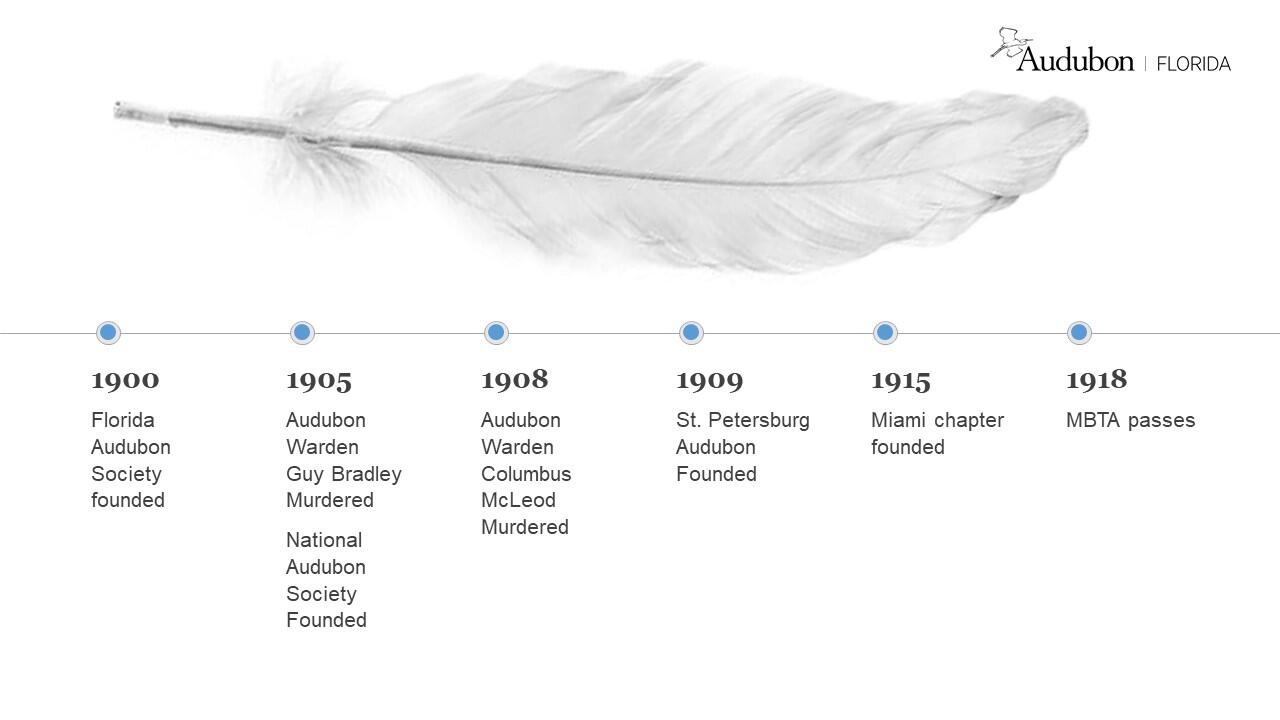
Although Audubon Assembly was held virtually this year, the event still provided an amazing array of learning sessions and field trips to engage its members, staff, and stakeholders. With a theme of Reimagining Audubon Florida: A Call for Inclusive Conservation, panel discussions and the Keynote Presentation focused on inclusive conservation. More than 600 people registered to participate in the various sessions, with even more engagement through social media. The event was made possible by our sponsors: Darden Restaurants, Florida Power & Light, Co., Wells Fargo, Duke Energy, Publix Supermarkets, Vortex Optics, The Merrill G. and Emita E. Hastings Foundation, Rayonier, Wild Birds Unlimited, and Vulcan Materials Company, with additional support from the Jessie Ball duPont Fund.
In an effort to improve accessibility, all sessions included the option for Spanish language interpretation.
October 20
5 p.m. Audubon 101
Florida has come a long way since the tragedy that gave rise to Audubon at the turn of the 20th century. Founded to prevent shooting birds for their nuptial feathers, we continue to advocate for birds and the places they need across the state. Learn more about our history here.

The presentation also included some of the most noteworthy victories accomplished over the past year:
- Setting an example for watershed restoration at Corkscrew Swamp Sanctuary - 18 acres completely restored and 670 of 1,000 acres partially restored.
- Center for Birds of Prey - admitted 676 birds and released around 200 birds while EagleWatch 2019-2020 season volunteers helped monitor 800+ eagle nests.
- CLI Program - the Conservation Leadership Initiative program was expanded to be a year-round program.
- Coastal Program - successful shorebird and seabird fledging despite COVID and tropical storms.
- Climate program - training now underway for climate advocates and a new climate roundup newsletter was launched to raise awareness of issues and potential solutions.
- Everglades Program - Audubon staff members are part of the team that has released more than 100 captive-raised Florida Grasshopper Sparrows into the wild. Moreover, staff championed the appropriation of $100 million for the Florida Forever program.
6: 15 p.m. Chapter Celebration
Chapter Conservation Manager Jacqui Sulek introduced chapter leaders from around the state and led a celebration of their successes. Highlights included Duval Audubon’s children’s Christmas Bird Count, which engages as many as 50 youngsters and their parents through a partnership formed with the local zoo; Orange Audubon Society’s Lake Apopka Wildlife Drive Ambassador Program; South Florida Audubon’s dune restoration project along 23 miles of Broward beaches; Peace River Audubon Society’s Native Plants for Birds Yard Certification; Manatee County Audubon Society’s restoration and management plans at Felts Audubon Preserve; and many, many more. The celebration concluded with some words from Florida Power & Light Company’s grant program manager Meredith Rollo, who announced that all chapters that submitted proposals for the 2020-21 Plants for Birds grant cycle are winners! See the list of chapters here.
October 21
5 p.m. Outdoor Hacks: Tips and Tricks for Enjoying the Outdoors Safely
Panelists: Mark Rachal, Koko Bergers, Rafael Galvez, Dr. Jameson Mercie
Moderator: Lauren Gay, "the Outdoorsy Diva"
Panelists agreed that the most important thing about getting outside is to feel comfortable! Some hacks for staying cool include: using tea or mint leaves in your water for extra hydration; plan your trip earlier in the day; wear a wide brim hat and long sleeve shirt and pants; consider purchasing long pants with zippers that convert to shorts; try to find clothes made of wicking material that will draw the moisture out and away from the body. A really important tip for staying safe in the Florida outdoors – focus on hydration! Pack more water than you need, and use insulated, reusable bottles if possible. Plan to drink a half-liter per hour if you are hiking.
The panel concluded with this thought: the outdoors is for everyone! Don’t overthink it – just GO!
October 22
5 p.m. Outdoors for All: How Racism Impacts Outdoor Experiences for People of Color
Panelists: Natasza Fontaine, Herbie Zephir, and Clive Pinnock
Moderator: Barbara Roole, the Director of Equity for the Jessie Ball duPont Fund in Jacksonville
Inspired by the experience of Black birder Christian Cooper in Central Park’s Ramble, this moderated panel discussion focused on individual experiences of being Black outdoors. All of the panelists shared similar experiences of being the only person of color in their early birding experiences. “Safety is always a concern because of the looks I get going to certain places,” said one panelist.
When asked what advice they might have for the audience in terms of being more inclusive of people of color when out in natural spaces, they agreed it’s the small, welcoming gestures that make a huge difference. Take simple conversation a step further and engage people of color as fellow birders. Be welcoming, and help make people feel comfortable about being outdoors.
October 23
5 p.m. How Climate and Water Quality Affect Communities of Color and Low Income: Opportunities for Conservation and Justice
Panelists: Salome Garcia, Policy and Campaigns Manager, The CLEO Institute; Alex Harris, Miami Herald climate reporter; Jeremy Orr, staff attorney, Safe Water Initiative at NRDC
Moderators: Audubon Florida's Beth Alvi and Laura Aguirre
This panel addressed how climate change, wetland loss, and shrinking green space impacts communities of color disproportionately. What are the inequalities of conservation? Extreme heat and extreme weather events can affect communities of color more than other communities. Also, while all humans have a right to clean water, climate change perpetuates the divide of safe, affordable water in those communities that struggle for it. Even when water is available, it is often of poor quality and may even contain toxic substances like lead, issues that are not quickly addressed when they impact communities of color. Similarly, low-income families sometimes need to decide between clean water and other necessities. When addressing climate change, everyone is affected, but disenfranchised communities are not affected in the same ways as wealthy ones. For example, after an extreme weather event, certain areas are left roofless for long periods of time with mold, and without medical supplies.
October 24
9:45 a.m. Conservation Agenda Setting Workshop
The final day of Audubon Assembly began with a presentation of the 2021 Conservation Action Agenda by staff and Regional Conservation Committee chairs. State conservation priorities are grouped into the following topics: Coastal, Water, Climate, Working Lands, and Bird-Friendly Communities. Seven regional conservation committees bring chapters together to collaborate on conservation issues and pathways to solutions from Southwest Florida, Everglades, Indian River Lagoon, Central Florida, Florida Gulf Coast, Northwest Florida, and Northeast Florida.
Participants were provided the opportunity to vote for or against each priority. With near-unanimous acceptance, these resolutions became Audubon’s conservation agenda for the year, guiding advocacy efforts in a culmination of the yearlong process.
11 a.m. Keynote Presentation: J. Drew Lanham, Ph.D.
Dr. Lanham asked Assembly participants to take a moment to think about how we connect with the birds that we all love. Conservation brings us together.
Lanham said that it is critically important that we not only identify birds we see but identify with the birds we see. To emphasize this point, he confessed that he doesn’t keep a life list of species, but has instead moved into a different mode of birding – identifying with the birds.
“The calls of Long-billed Curlews and Western Meadowlarks on the Montana prairie thrill me to the very depths of my being.”
Lanham owes his life to birds in so many ways and can still recall each and every species he has seen. But, those moments with people who share his passion make birding not just a pastime, but a way to build strong connections with other people and the natural world. Instead of writing down a list of the birds he’s seen, he carries a mental list of the people who have made this the journey of his life.
“After all of my time in the field is done, the memories of the birds and these bird-filled events remain, but the people live deep within my heart as well.”
Birding challenges must be overcome at many levels. Even the sweet song of sparrows has been soured during an incident he experienced near a farm, when the farmer approached him with racist comments. He drew strength from the birding allies he has encountered over the years and moved forward.
Dr. Lanham stresses the importance of seeing beyond our binoculars. That message of a “broader vision” has come across in Assembly this week. How do we go forward? Dr. Lanham hopes that we all consider not just the listing, but the being of birds. His mantra: we share the same air, water, soil, earth, and fates. Those fates are shared not only by humans but by feathered beings as well. We have a responsibility to one another and to the birds in these shared fates. Beyond our binoculars, we can continue in this passion together.
In closing remarks, Julie Wraithmell thanked participants, staff, and everyone who made Assembly possible (moderators, panelists, consultant Lauren, interpreters), encouraged the audience to enjoy or share their copy of Lanham’s “The Home Place,” and to keep the conversation going.



